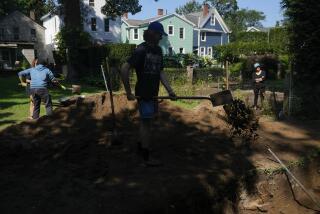1,000 Graves : Paving Project Turns Up Old Burial Ground
- Share via
SANTA ROSA, Calif. — Officials are expressing wonder over the discovery of an overgrown, century-old cemetery where, they believe, 1,000 indigents and Chinese were buried.
“The thing that’s hard to believe is you could bury 1,000 people on a site and then forget it ever existed,” said Sonoma County architect Rene Cardinaux.
Some of the graves are marked only by small cans filled with cement and stamped with numbers.
One woman wasn’t surprised about the cemetery. Song Bourbeau said her father, Tom Wing Wong, was buried at the two-acre site in 1918. She said the existing burial ground in the area, the Odd Fellows Cemetery, didn’t permit burial of Chinese in the early century.
Founded in 1876
Records indicate the cemetery probably was founded in 1876 and was part of the county’s poor farm.
Cardinaux and his staff this week got a list from Community Hospital of 450 people who apparently were buried at the site near Oakcrest. The architect believes it is only a partial list, and that the number may actually be 1,000.
The county has plans to pave over a small part of the cemetery, now nearly hidden in weeds, evergreens and poison oak, for a Family Practice Clinic parking lot.
Cardinaux said he will suggest to county supervisors that the site be cleaned up and possibly posted with a small memorial.
“We’re really groping around,” he said, complaining that no one seems to know how many people were buried there or why the site was never given any designation besides a barbed-wire fence to keep out cattle.
Patients Disturbed
Cardinaux said he has one account that the grave sites’ headstones were replaced with numbered markers because the tuberculosis patients in the adjoining hospital got upset looking out on two acres of departed folks.
But officials have found no records indicating when the burials began on the property, which one county history report says the county purchased in 1876 for $5,000.
The heading atop the list of 450 names is “Catalogue of Grave Markers.” Besides names and the dates of birth and death, the list contains numbers in no specific order ranging from 100 to 976.
One of the architect’s staff members, Ken Meyer, said he had seen markers numbered from as low as 150 to as high 1,500. From that, Cardinaux has guessed there might be 1,000 graves spread over 70,000 to 100,000 square feet.
Gardner Burke, a former county hospital administrator, remembered that a maintenance worker “used to insist somewhere in my office files there should be a list of the people buried there.”
After a lengthy search, he said, the hospital discovered what appeared to be “only a partial list,” apparently the same one given to Cardinaux.
More to Read
Sign up for Essential California
The most important California stories and recommendations in your inbox every morning.
You may occasionally receive promotional content from the Los Angeles Times.










